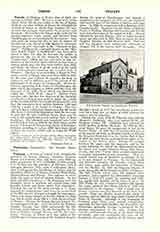

Turpin, Archbishop of Reims, date of birth uncertain; d. September 2, 800. He was a monk of St. Denis when, about 753, he was called to the See of Reims. With eleven other bishops of France he attended the Council of Rome in which Pope Stephen III condemned the antipope Constantine to perpetual confinement. He enriched the library of his cathedral by having numerous works copied, and obtained from Charlemagne several privileges for his diocese. Leg-ends grew up around his life, so that by degrees he becomes an epic character who figures in numerous chansons de geste, especially in the “Chanson de Roland”. Furthermore, a chronicle known as the “Historia Karoli Magni et Rotholandi” has been attributed to him; but that he was not the author is proved by the use in the chronicle of the word “Lotharingia” which did not exist prior to 855, the mention of the musical chant written on four lines, a custom which does not date back further than 1022, and finally the silence of all the writers of the ninth and tenth centuries regarding this so-called book of Turpin’s. The first to mention him is Raoul de Tortaine, a monk of Fleury, who wrote from 1096 to 1145. At the same time Calistus II regarded the book as authentic, and its diffusion revived the fervor of the pilgrimages to St. James of Compostella. In it is related an apparition of St. James to Charlemagne; the saint orders the emperor to follow with his army the direction of the Milky Way, which was thenceforth called the “Path, of St. James”. Gaston Paris considers that the first five chapters of the chronicle attributed to Turpin were written about the middle of the eleventh century by a monk of Compostella, and that the remainder were written between 1109 and 1119 by a monk of St. Andre de Vienne. This second part has a real literary importance, for the monk who wrote it derived his inspiration from the chansons de geste and the epic traditions; hence there may be seen in this compilation a very ancient form of these traditions. The chronicle was translated into Latin and French as early as 1206 by the cleric Jehan, in the service of Renaud de Dammartin Count of Boulogne. Editions according to various MSS. have been issued at Paris by Castets (1880) and at Lund by Wulff (1881).
GEORGES GOYAU

